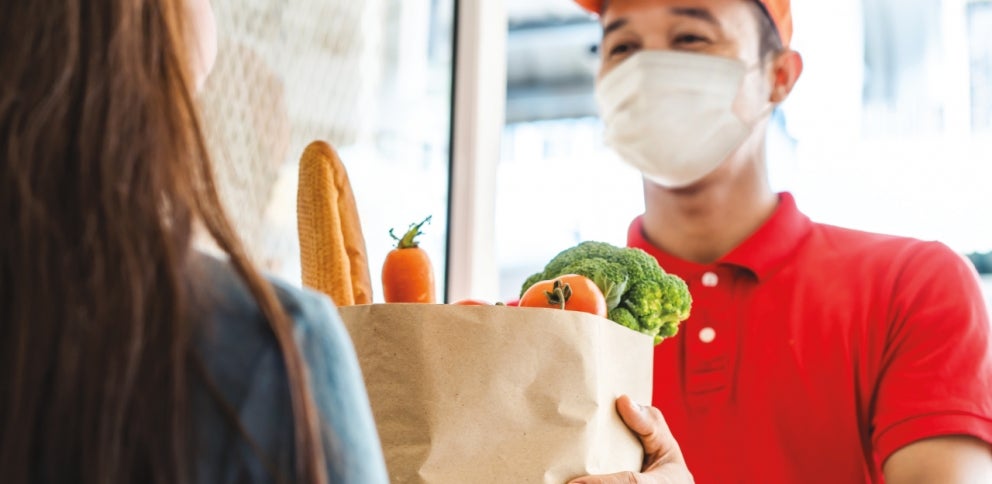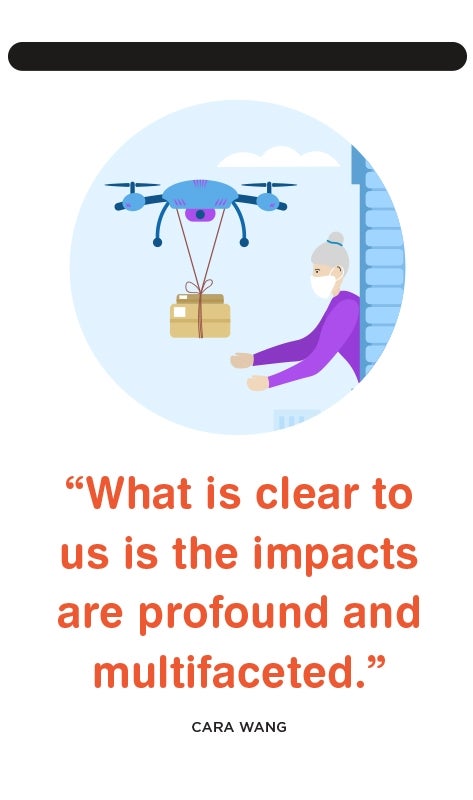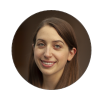

COVID-19: A Catalyst for Change
How a global pandemic sparked panic buying and forever changed how we shop.
By Regina Stracqualursi
In December 2019, the world heard about an outbreak of pneumonia in Wuhan, China, with an unknown cause. Meanwhile, the disease, later identified as COVID-19, was spreading — silently, rapidly, and widely — and would soon result in over 2 million deaths and change daily life as we once knew it. Today, many of us wake up and instead of getting into our cars and driving to work or catching a train or bus, we walk a few steps to our kitchen tables or home offices. Instead of gathering with friends and family, we attend Zoom happy hours and participate in drive-by birthday parades, and instead of going into a grocery store or restaurant, many of us order food online or opt for takeout or delivery.
The COVID-19 pandemic has forever changed us — both as individuals and as a society. It’s completely altered the way we live, work, learn, socialize, and relax. As the pandemic began, researchers at Rensselaer Polytechnic Institute wanted to understand and quantify these changes in human behavior. Collaborating with researchers from 15 universities across the globe, the team began collecting survey data to gain insight into these behavioral shifts, particularly in relation to the consumption of goods and services, in order to anticipate what the future might look like.
Buying Into a Supply Problem
Shortly after COVID-19 began to spread worldwide, shoppers swarmed grocery stores and supermarkets purchasing massive quantities of nonperishable food items, medications, cleaning supplies, and personal hygiene products — leaving shelves bare. It wasn’t long before many were left wondering what they were going to do once they ran out of diapers for their children or how they were going to keep their families safe from a highly contagious disease without any disinfectant. People also began stockpiling medical supplies they may not have had on hand before, such as face masks. As hospitals were flooded with an influx of patients battling the respiratory disease, it quickly became clear there was a shortage of supplies for health care workers who needed them most. By March 3, 2020, the World Health Organization issued a warning that the shortage of personal protective equipment was endangering the lives of the doctors, nurses, and emergency personnel in close contact with the virus every day.
Panic buying is not new but has never been quite as widespread as it has been throughout the COVID-19 pandemic. José Holguín-Veras, the William Howard Hart Endowed Professor of Civil and Environmental Engineering and director of the Center for Infrastructure, Transportation, and the Environment, has studied this behavior for nearly 20 years, since the Sept. 11, 2001 terrorist attacks. He’s studied everything from hurricanes Katrina and Irene, to the 2010 earthquake that devastated parts of Haiti, and the 2011 tsunami that took the lives of thousands in Japan. He and his team began following the coronavirus outbreak as soon as it started in Wuhan, and watched as the disease spread rapidly across the world. “It’s a global disaster unlike anything I’ve experienced in my whole life,” he says. “I have been in dozens of disasters, but nothing like this one.”

One of the main goals of their research is to understand why panic buying occurs, so solutions can be put in place to better protect those affected by and battling disasters. “What we are trying to do is to disentangle the motivating factors of this behavior,” Holguín-Veras says. “The reality is that supply chains are designed to be efficient.” In a survey distributed in more than 50 countries, the first international study of disaster-related purchasing, the researchers asked respondents about their typical purchasing habits and how they changed when the pandemic began. After data cleaning, about 7,000 responses from 20 countries and 1,500 responses from the U.S. revealed multiple motivations of panic buying, which is an umbrella term used for all disaster-related buying behaviors and a misnomer, as it often stems from rational considerations as opposed to panic.
With the data collected thus far, the researchers have identified panic buying motivations based on three recurring objectives: self-preservation, opportunism, and altruism. The majority of consumers tended to engage in panic buying in response to COVID-19 for reasons related to self-preservation. In fact, in the first three rounds of surveys distributed in the U.S, the majority of respondents gave reasons that fell into this category. As the pandemic began, these individuals purchased for valid reasons, such as needing supplies immediately, or having a family member who needed to isolate. However, the category also includes those who shopped with concerns for themselves or their families; fears that stores would close, or that supplies would run out; and worries that additional supplies could be needed in the future. While these reasons reveal a natural human reaction to a crisis or disaster, the associated behaviors have devastating effects on supply chains and disaster relief efforts. “The problem is, if we do not control ourselves and buy way more than what we need, we are depriving others of the supplies they need,” says Holguín-Veras. “Having six months of toilet paper is depriving others.”
In March 2020, The New York Times reported that two men purchased 17,700 bottles of hand sanitizer from stores throughout Tennessee and Kentucky, and began selling them on Amazon for a higher price. This form of panic buying, called opportunistic buying, occurs when individuals stockpile goods amid a disaster with the intention of selling those supplies for a profit. While only a small percentage of survey respondents indicated they stockpiled with an opportunistic intention, even a minuscule percentage of opportunistic buyers poses a huge threat to the success of disaster recovery efforts. “The number of items these individuals buy represents a major component of total purchases,” Holguín-Veras says. For instance, in the example of the hand sanitizer bottles, assuming a typical household stocked up on 10 bottles as the pandemic began, that opportunistic purchase alone represents 1,770 households. Similar instances occur when individuals stockpile goods with the intention of donating them, to aid with disaster relief. While these shoppers, driven by altruism, have good intentions, they should leave the supplies in the market for the officials who are responding to a crisis or disaster. “These are the same supplies needed by first responders,” says Holguín-Veras.
In addition to understanding why people engage in panic buying, the research team is looking for insight into how the behaviors could be reduced or eliminated in the future. “Panic buying is driven by a lack of trust,” Holguín-Veras says. “These individuals have doubts that the public and private sectors will be able to deliver the supplies they need.” The survey asked respondents how much they trust various groups, such as firefighters, police officers, health officials, relief organizations, news media, and governments on local, state, and national levels. Based on the data collected, the researchers believe a strategy involving emergency relief organizations and local emergency responders and governments, with support from the general public, could encourage people to refrain from engaging in such behaviors. Likewise, the survey results could also influence future emergency response plans. For example, plans could include collaboration agreements between public and private sectors to aid with inventory management during a crisis. “In a situation like this, you must ration supplies,” says Holguín-Veras. “If not, it is simply impossible to satisfy all needs.”

Predicting the “New Normal”
Cara Wang, associate professor of civil and environmental engineering, has been analyzing transportation data for over a decade. In recent years, she has been studying the growing trend of home deliveries resulting from online purchases, and its effect on transportation systems. As the COVID-19 outbreak began, she noticed a shift in behaviors that have a significant impact on transportation systems, such as travel activity patterns and online shopping habits. Working with Holguín-Veras and the team of researchers, she began collecting survey data to both quantify and understand these behavioral shifts. “Traditionally, people have had to travel in order to complete many activities,” Wang says. “Information and communication technologies have changed the game.”
Two sets of surveys revealed that respondents’ total travel activity was reduced by over 65% as the COVID-19 outbreak began and that it is expected to remain about 5% less than before the pandemic, once it ends. In addition to statewide stay-at-home mandates, the decrease is attributed to mandatory trips, such as those to work, school, or day care, activities that will likely remain decreased once the pandemic subsides. In fact, the survey revealed that more than 50% of respondents will continue working from home in some capacity. Respondents also tended to reduce entertainment-specific travel activity significantly during the pandemic, though they anticipate those activities will eventually return to normal levels. “People’s entertainment needs are quite stable,” Wang says.

One of the biggest shifts in behavior sparked by COVID-19 was a rapid adoption of e-commerce, and online grocery delivery, in particular. By April 2020, popular grocery delivery service Instacart hired more than 300,000 workers in just one month to meet a growing demand. The survey showed that respondents increased their average number of monthly grocery deliveries by over 130% and expect to increase it by over 60% when life returns to “normal.” “As people adopt the new shopping behavior, some of them see the benefits and decide to continue the delivery service, with either the same or lower intensity,” says Wang.
Given these preliminary findings, the researchers believe that a “new normal” will likely emerge that is somewhere in between the behaviors exhibited before and during the pandemic, and will certainly have long-lasting effects on transportation systems. They hope their research can help officials develop policies that maximize the benefits of the behavioral shifts resulting from the pandemic and mitigate effects that are potentially detrimental. While there has been a common misconception that people are reducing congestion and their own carbon footprints by staying home, that likely won’t remain true once life normalizes. “We cannot just assume we’ve reduced our externalities because we’ve stayed home,” says Wang.
According to Nature Climate Change, there was a decrease in daily global carbon dioxide emissions during the periods of forced confinement during the pandemic; however, the survey revealed that respondents still intend to visit stores in person once the pandemic subsides, in addition to taking advantage of online delivery services. Those online deliveries result in more overall travel activity, potentially increasing both congestion and emissions. “We are looking into potential policies that could help people realize the externalities they generate just by shopping online a lot,” says Wang. She believes educational programs or incentives could be developed to encourage people to take action to reduce their externalities. “We are looking into what people care about so that we can find the most efficient solutions,” she says.
Some of the behavioral shifts from COVID-19 may also benefit transportation systems. In prior research, Holguín-Veras and Wang tried to find ways to solve many of the logistical problems resulting from an influx of home deliveries generated by online shopping. In 2019, they surveyed online shoppers to see if they were open to receiving packages in a different way, such as in lockers, to their workplace, at night, or in consolidated deliveries. The behavioral shifts from the COVID-19 pandemic could present ways to solve such problems. For example, the wide adoption of telecommuting and the likely continuation of telecommuting policies could present an opportunity for policymakers to work with companies to reduce traffic during typical commuting hours. Allowing flexible work schedules would keep employees safer in the event of a future virus outbreak, while also benefitting transportation systems in many ways. “We’ve spent years trying to find ways to flatten the peak hours of congestion,” Wang says. “Now, we finally see a new opportunity.” The research team will continue collecting data in the hope that they can track behavioral trends to the different stages of the pandemic and better predict its long-term effects. “What is clear to us is the impacts are profound and multifaceted,” says Wang.
















